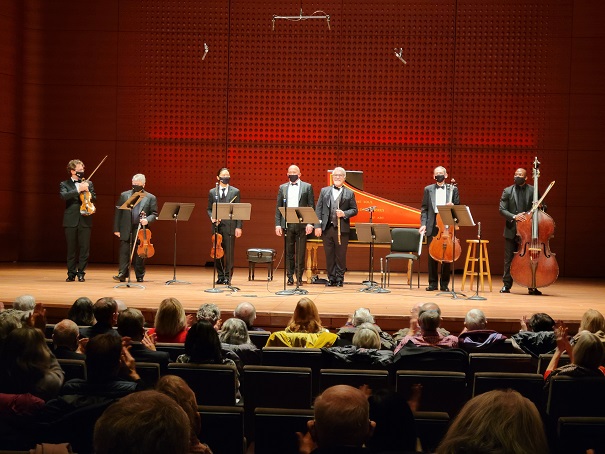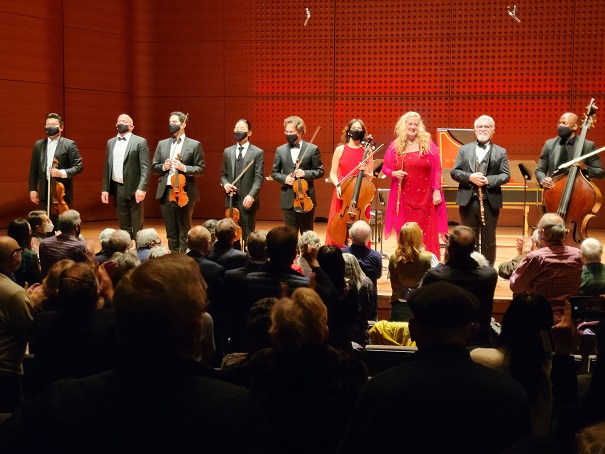Concert Diary: CMS Plays the Brandenburgs
December 20, 2021
New York, N.Y.
Bach’s Brandenburg Concertos were like a gateway drug for me. I first heard the 3rd and the 4th in Wendy Carlos’s Moog versions in the late 60s and early 70s, and during my freshman year of college (71–72), I started binging on LPs. I loved the exuberance of the Brandenburgs, the vibrancy as well as the intricacy. There’s so much going on!
From the Brandenburgs, my interest in Bach extended over more of his music, and then I got into other late-Baroque composers such as Handel and Vivaldi and Domenico Scarlatti, and then I discovered music after the Baroque.
I’m not sure when I last saw a Brandenburg Concerto performed live. Maybe decades. But I made up for that yesterday afternoon when the Chamber Music Society of Lincoln Center performed all six Brandenburgs at Alice Tully Hall.
Performing practices of the Brandenburg Concertos have changed over the years. At one time it was common for big orchestras to play them, but that’s that’s not done much anymore. They tend to sound a lot better with only one instrument per part as Bach intended. This is the practive of the CMS. But unlike ensembles that specialize in perforning with authentic Baroque instruments (such as valveless horns and trumpets, and keyless oboes and flutes), the CMS sticks to modern instruments, including what seems to be a modern harpsichord.
In yesterday’s concert, the CMS played the Brandenburg Concertos in the order 1, 3, 5, intermission, 2, 6, 4, but each one has a distinctive sound and “personality,” so I like to think of the individual Brandenburgs as if they had titles much like episodes of the sitcom Friends.
For example, Brandenburg Concerto No. 1 is “The One with the Horns” or “The One with the Weird 4th Movement”. Besides the two natural horns (or French horns in the CMS performance), the first Brandenburg also calls for three oboes, a bassoon, two violins, and a higher-pitched piccolo violin, which is usually played on a conventional violin. I love the gorgeous slow movement where an oboe and the piccolo violin wind long melodes around each other.
The 1st Brandenburg would sound perfectly complete and acceptable if it ended after the third movement, and indeed, the CMS audience broke into applause. But inexplicably, there’s more! It turns into a suite of sorts featuring a Minuet, Trio, and Polonaise. It’s never made much sense to me.
Brandenburg Concerto No. 3 is “The One with the Strings” or “The One with No Slow Movement”. Three violins, three violas, three cellos, which ostensibly is an odd balance of strings, but the effect is mesmerizing. For the second movement, Bach left a couple of chords perhaps to finish off an improvisation, but the CMS didn’t bother getting fancy about it. This was my favorite in my younger years when I enjoyed surging fast movements the most. In my older years, I like the slow movements much better, which this one doesn’t have.
Brandenburg Concerto No. 5 is “The One where the Harpsichord Goes Wild”. Towards the end of the first movement, the solo violin and flute and the rest of the ensemble drop out leaving the harpsichord to play alone. This was unprecedented in its day, and it’s still quite fun. Yet once again, it’s the slow movement with harpsichord, violin, and flute that I find most enticing.
In the center are solo violinist Stan Lee, harpsichordist Kenneth Weiss, and flutist Ransom Wilson, surrounded by the rest of the ensemble in curtain calls for the 5th Brandenburg:
Following intermission, we heard the even numbered Brandenburgs starting with No. 2, which is, of course “The One with the Trumpet”, more specifically a piccolo trumpet played by David Washburn. The trumpet abstains during the gorgeous slow movement featuring violin, flute, and oboe, but returns spectacularly in the finale.
The 6th Brandenburg was next, which I think of as “The One without Violins”. In a historically informed performance, two violas play along with two viola da gambas, but the CMS used cellos instead. The absence of violins and woodwinds give this one a very dark-hued nature. The gigue finale is not quite a great conclusion to a concert, which I suspect is why this one wasn’t left for the end.
Instead, the concert concluded with Brandenburg Concerto No. 4, which is “The One with Two Recorders” or (as the CMS performed it) “The One with Two Flutes”. This one is now perhaps my favorite, but I do prefer hearing it with recorders. I love the interaction of the recorders with the solo violin, and the way the two recorders weave in an out of each other in the slow movement. The fugue finale is a real blast!
Here’s solo violinist Alexander Sitkovetsky (5th from left) and flutists Tara Helen O’Connor and Ransom Wilson during curtain calls:
It’s getting to feel a lot like Christmas, so the CMS gave us goody bags on the way out of Alice Tully Hall, containing a packet of cocoa mix and a gingerbread man:
But now he’s gone to a better place.


